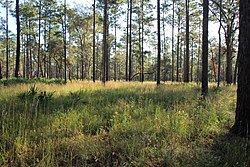Sandhill

Asandhillis a type ofecological communityorxericwildfire-maintainedecosystem.It is not the same as a sanddune.It features very short fire return intervals, one to five years. Without fire, sandhills undergoecological successionand become moreoakdominated.
Entisolsare the typical sandhillsoil,deep well-drained and nutrient poor. InFlorida,sandhills receive 130 cm (51 in) cm ofrainfallper year, just like the morehydricecosystemssurrounding them. Sandhills are xeric because they have poor water holding capacity.
Dominant vegetation includeslongleaf pine(Pinus palustris), American turkey oak (Quercus laevis), and wiregrass (Aristida stricta).[1]A number of rare animals are typical of this habitat including the gopher tortoise (Gopherus polyphemus),[2]red-cockaded woodpecker(Picoides borealis), Sherman's fox squirrel (Sciurus niger shermani),[2]and striped newt (Notophthalmus perstriatus).Invasive speciesthat are a problem on sandhills include Cogongrass (Imperata cylindrica),[3]camphor laurels (Cinnamomum camphora), andNatal grass(Melinis repens).
See also
[edit]- Athabasca Sand Dunes Provincial Park– Provincial park in Saskatchewan, Canada
- Flatwoods– Ecological community in the southeastern coastal plain of North America, another ecological community in the coastal plain of North America
- Florida longleaf pine sandhill– Ecological region of Florida, US
- Monahans Sandhills State Park– State park in Texas, United States
- Nebraska Sand Hills– Temperate grasslands, savannas, and shrublands ecoregion of Nebraska, United States
References
[edit]- ^Canfield, Susan Littell; Tanner, George W. (1997)."Observations of Pineywoods Dropseed (sporobolus Junceus) Phenological Development Following Fire in a Sandhill Community".Florida Scientist.60(2): 69–72.ISSN0098-4590.JSTOR24320744.
- ^abHerring, Brenda J.; Judd, Walter S. (1995)."A Floristic Study of Ichetucknee Springs State Park, Suwannee and Columbia Counties, Florida".Castanea.60(4): 318–369.ISSN0008-7475.JSTOR4033806.
- ^Jose, S.; Cox, J.; Miller, D.L.; Shilling, D.G.; Merritt, S. (2002-01-01)."Alien Plant Invasions: The Story of Cogongrass in Southeastern Forests".Journal of Forestry.100(1). Oxford Academic: 41–44.doi:10.1093/jof/100.1.41(inactive 2024-04-10).ISSN0022-1201.Retrieved2024-02-27.
{{cite journal}}:CS1 maint: DOI inactive as of April 2024 (link)
